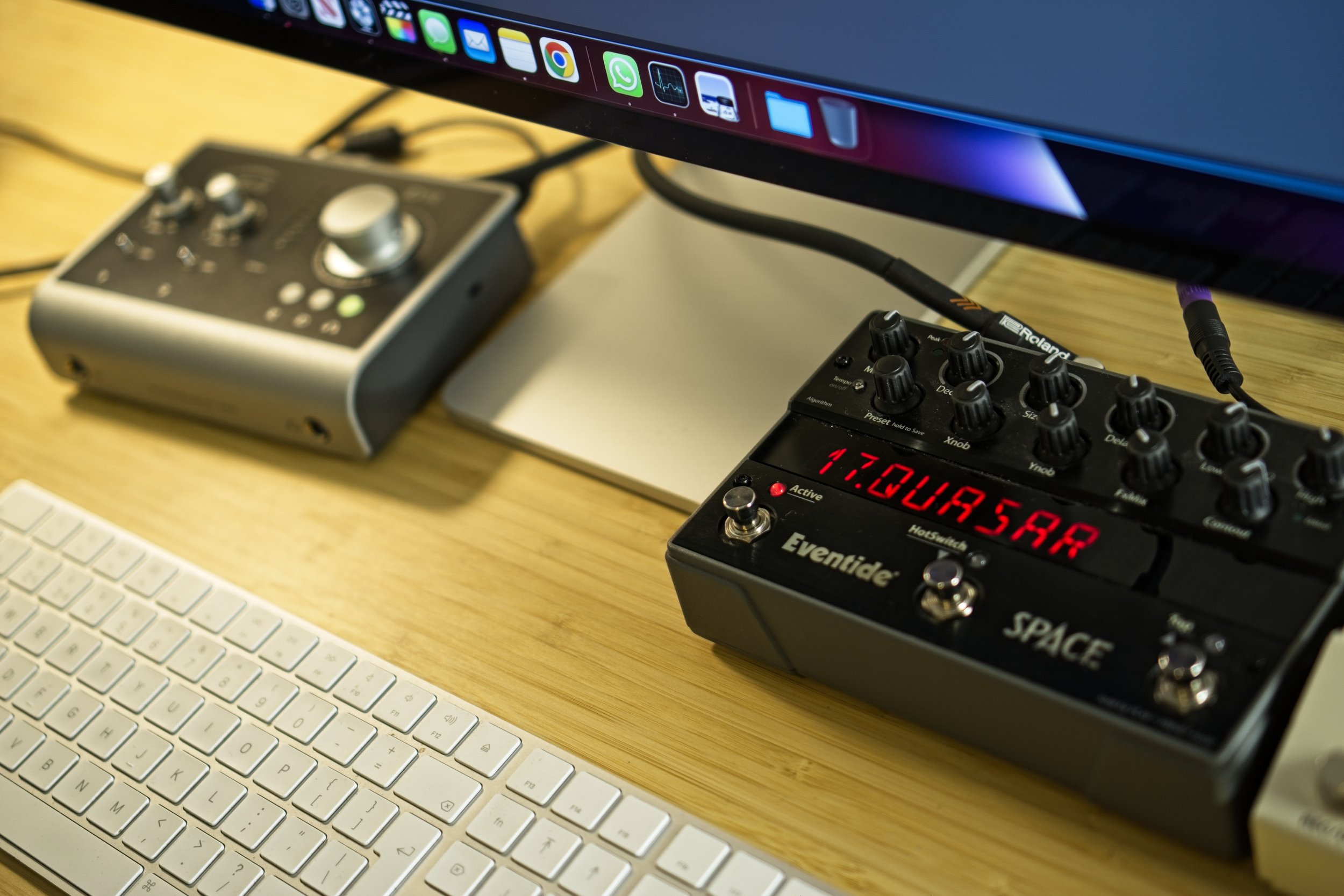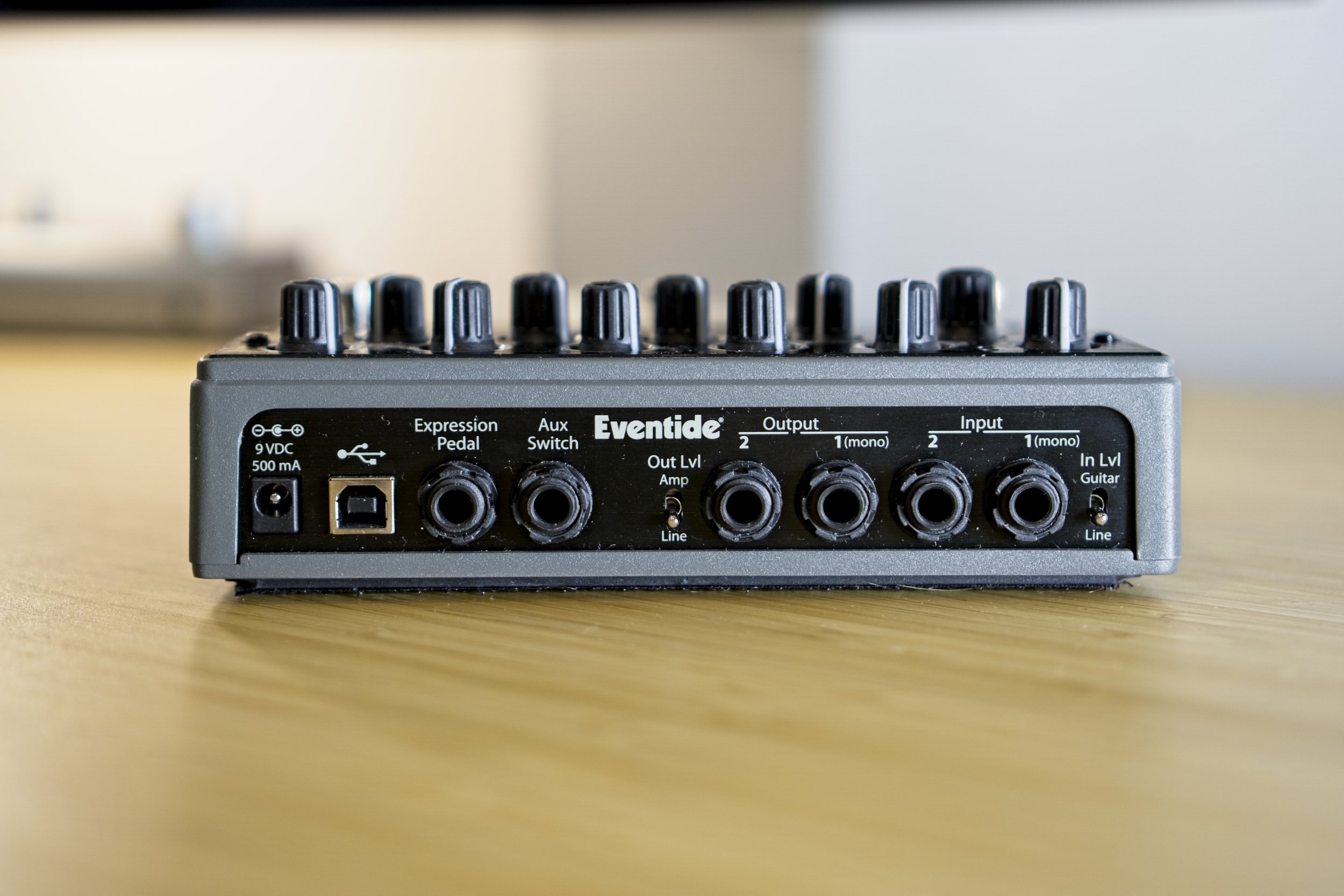Eventide Space Reverb
Studio reverb 50 years in the making.
£499 at thomann.de | £499 at andertons.co.uk
Eventide have been doing digital audio processing since the early 1970s. Their equipment has been widely used for music production, broadcasting and telecommunication. Their H9000 Rackmount is one of the best most expensive (£6,000) effects processors in the world. The Eventide Space pedal brings the reverb algorithms from the H9000 into a more affordable and pedalboard-friendly format. Is all this power and versatility worth the £500 price tag? Let’s find out.
Features
In addition to being a guitar pedal, the Eventide Space is a studio-quality effects processor. Both the input and the output of the pedal can be set to either guitar/amp or line level – you can use the Space with a typical guitar/amp setup or run it directly into your mixer for recording. The pedal features stereo inputs and outputs and is fully MIDI-controllable. It offers 12 unique reverb algorithms from the H9000 with 9 fine-tunable parameters each. An expression pedal can be set up to do anything from sweeping through multiple parameters at once to controlling the volume of either your wet or dry signals.
The Space has 2 modes of operation. The left footswitch can be used at any time to turn the effect on or off in either mode. In Preset Mode you can cycle through the 100 user-configurable presets with the right and middle footswitches, then confirm with the left footswitch. This is very intuitive and the big screen clearly shows the name of the preset you are about to select. You can change the algorithm of a preset by pressing down the Preset knob. Set all the knobs to your desired settings and hold the Preset knob again for a few seconds to save/rename the preset. If messing with the settings on the pedal is not for you, the H9 Control app lets you set everything up on your computer.
To switch to Play Mode, hold the right footswitch for a few seconds. Now the right footswitch is used for tap tempo and the middle footswitch can hotswitch one or multiple parameters. To set it up, just hold the middle footswitch for a few seconds, change the desired parameters to their new values and press the middle switch again – you’ve now saved the new parameters. You can set these changes to happen instantaneously or gradually over a short period of time.
One annoying feature of the Space is that the inputs are on the top left and the outputs are on the right, making it awkward to place on a pedalboard.
Overall, the feature set is extremely comprehensive. If you can think of it, there is likely a global or preset setting for it.
Sound
The Eventide Space comes with 12 different algorithms, all of which are also found on their expensive rack units. The knobs on the Space will control different parameters, depending on the algorithm. Despite Eventide’s best efforts to label them consistently, I still don’t have a clue what each knob will do. Luckily the big LED screen will let you know what each knob does as soon as you start turning it.
The thing that makes the Space stand out among other reverb pedals is just how easy it is to get a great-sounding reverb, no matter the settings. I have spent countless hours messing around with all the algorithms finding new and interesting combinations. It also has some of the best reverb presets I have ever heard. All 100 existing onboard presets are unique and will inspire you to write creative riffs and melodies.
The Hall, Room and Plate are all pretty self-explanatory and their sound quality is second to none. They sound very full and are easy to dial in a great reverb with. They also offer additional tremolo and modulation features.
Dual Verb combines two independent reverbs with full control over their mix, decay, pre-delay and tone. It sounds great and it sounds huge.
Reverse is quite unique in that the reverse reverb is followed by a regular reverb. This tames the atonal weirdness, normally accompanied by reverse reverbs and delays. You can fully control the mix between the two, including getting rid of the normal reverb altogether.
ModEchoVerbis a beautiful mess of chorus, flanger, phaser and infinite delay. It can be a bit tricky to control, but will sound amazing on the right track.
The Black Hole is one of the best and most unique algorithms in the unit. It takes a huge cathedral-type reverb and adds loads of feedback. Unlike other reverbs with strong feedback, the Black Hole is very easy to control. This sound was so popular, Eventide made a smaller and cheaper pedal that only does the Black Hole reverb.
Mangled Verb is a reverb fed through distortion. Once again Eventide flex their digital signal processing experience, as it just sounds musical with almost any settings. Try putting a distortion pedal behind your reverb and see what happens. It can be done with some tweaking, but I never managed to make it sound this good.
Dyna Verb is a reverb fed through a compressor. In fact, it is two of Eventide’s famous plugins combined into one algorithm – the Eclipse Reverb and the Omnipressor. You can apply the Omnipressor to either the reverb, your dry signal or a mix of both.
Shimmer is my favourite algorithm. The reverberation is pitch-shifted according to your specified parameters. There are two reverbs that can have different pitch changes. This Shimmer sounds very lush and harmonically rich. Other companies offer the Shimmer effect too - Strymon, Line6, TC Electronic. I have never heard one that sounds as good as this one.
Hopefully, this has convinced you that the Eventide Space is more than just a reverb pedal. Not only does it have best-in-class reverb tones, but you also get some delay and various modulation, and even compression effects.
If you just want to use the unit for recordings, Eventide’s plugins offer identical algorithms at a lower price. If you want a do-it-all modulation machine on your pedalboard, the H9 pedal by Eventide offers all the algorithms from the Space, Modfactor Timefactor and Pitchfactor pedals, crammed into a more pedalboard-friendly size. Be prepared to configure it with a mobile app though!
Build Quality
The knobs and switches are all sturdy and perfectly smooth in operation. The enclosure is made from metal, but the edges are rounded and textured making it easier to hold and less likely to get scratched. The attention to detail on this pedal is almost unnecessarily perfect.
Something I have never seen from any other pedal company is the support when it comes to repairing your expensive pedal. On the Evenide website, you can purchase everything from new potentiometers to replacement foot switches and power sockets. They are very reasonably priced too. A DC power jack for the Space is just £1.
Eventide’s dedication to customer support is notable too. They continue supporting their effects processors long after they get discontinued. The staff are very responsive on forums, whether you purchased their products new or second-hand.
Bottom Line
If delay is at the core of your tone, then the Eventide Space should be at the very top of your list of pedals to consider. Not only is it a phenomenal gigging tool, but it will also cover all your recording needs whether you play the guitar, bass or synth. It will last you a lifetime and if there are ever any issues you can be sure that Eventide will have you covered. That said, there are more versatile multi-effects processors out there that might satisfy your reverb needs while offering many other high-quality effects. An HX Stomp for the same price can replace your entire rig with similar sound quality to the Eventide Space.




